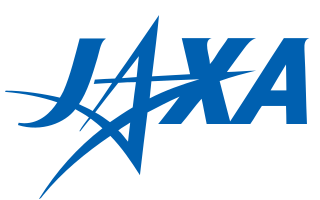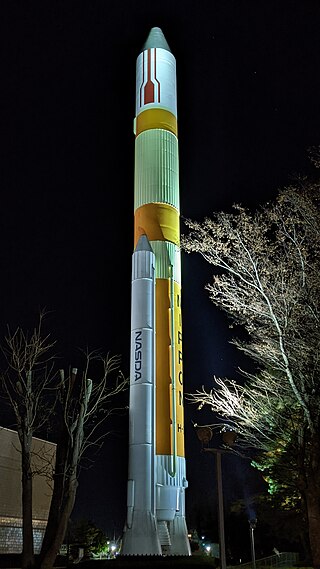
An expendable launch system is a launch vehicle that can be launched only once, after which its components are destroyed during reentry or impact with Earth, or discarded in space. ELVs typically consist of several rocket stages that are discarded sequentially as their fuel is exhausted and the vehicle gains altitude and speed. As of 2024, fewer and fewer satellites and human spacecraft are launched on ELVs in favor of reusable launch vehicles. However, there are many instances where a ELV may still have a compelling use case over a reusable vehicle. ELVs are simpler in design than reusable launch systems and therefore may have a lower production cost. Furthermore, an ELV can use its entire fuel supply to accelerate its payload, offering greater payloads. ELVs are proven technology in widespread use for many decades.

The Japan Aerospace Exploration Agency (JAXA) is the Japanese national air and space agency. Through the merger of three previously independent organizations, JAXA was formed on 1 October 2003. JAXA is responsible for research, technology development and launch of satellites into orbit, and is involved in many more advanced missions such as asteroid exploration and possible human exploration of the Moon. Its motto is One JAXA and its corporate slogan is Explore to Realize.

H-IIA (H-2A) is an active expendable launch system operated by Mitsubishi Heavy Industries (MHI) for the Japan Aerospace Exploration Agency. These liquid fuel rockets have been used to launch satellites into geostationary orbit; lunar orbiting spacecraft; Akatsuki, which studied the planet Venus; and the Emirates Mars Mission, which was launched to Mars in July 2020. Launches occur at the Tanegashima Space Center. The H-IIA first flew in 2001. As of September 2024, H-IIA rockets were launched 49 times, including 43 consecutive missions without a failure, dating back to 29 November 2003.

The Tanegashima Space Center (TNSC) is the largest rocket-launch complex in Japan with a total area of about 9,700,000 square metres. It is located on the southeastern tip of Tanegashima, an island approximately 40 kilometers (25 mi) south of Kyushu, an island and region in Japan. Construction on the site started in 1966. It was established in 1969 when the National Space Development Agency of Japan (NASDA) was formed, and is now run by JAXA. The activities that take place at TNSC include assembly, testing, launching, and tracking satellites, as well as rocket engine firing tests.

Telesat, formerly Telesat Canada, is a Canadian satellite communications company founded on May 2, 1969. The company is headquartered in Ottawa.

The H-II (H2) rocket was a Japanese satellite launch system, which flew seven times between 1994 and 1999, with five successes. It was developed by NASDA in order to give Japan a capability to launch larger satellites in the 1990s. It was the first two-stage liquid-fuelled rocket Japan made using only technologies developed domestically. It was superseded by the H-IIA rocket following reliability and cost issues.
Information Gathering Satellite are the satellites of the Japanese spy satellite program. It was started as a response to the 1998 North Korean missile test over Japan. The satellite program's main mission is to provide early warning of impending hostile launches in the region. This program is under the direct control of the cabinet. All Information Gathering Satellites have been launched by H-IIA rockets from the Tanegashima Space Center.

The Optical Inter-orbit Communications Engineering Test Satellite (OICETS), also called Kirari, was an experimental satellite launched by JAXA to demonstrate interorbital communication between satellites through optical (laser) means. OICETS was originally slated for a launch on the second J-I launcher. Due to problems with that launcher, the launch had to be put on hold. Using the H-IIA was out of question: it would have been overkill to use the H-IIA to send a 570 kilograms (1,260 lb) satellite into low Earth orbit, and there was no budget for another H-IIA launch. Finally, in order to be able to perform the tests during the lifetime of the European Artemis satellite, OICETS was successfully launched on a Russian-Ukrainian Dnepr rocket.
The Small Demonstration Satellite (SDS) is a spacecraft or satellite which is built as part of a JAXA programme to develop and demonstrate technology for and through small satellites. One of the mid-term goals is also to demonstrate formation flying. SDS-1 launched aboard an H-IIA rocket on 23 January 2009, as a secondary payload to GOSAT. The operation finished successfully on September 8, 2010.
JAXA Engineering Test SatelliteETS-VIII was the eighth technology test satellite in a series which started with ETS-1 in 1975 by NASDA. It was launched with the H-2A on December 18, 2006. ETS-VIII was developed by JAXA in cooperation with NICT and NTT. The aim of ETS-VIII was to enable satellite communications with small terminals. Unlike the Iridium satellites for mobile communication, ETS-VIII was positioned at GEO. However to fulfill the task, it was essential that the satellite carried two very large antennas. It was the first use of the 204 configuration of the H-IIA launch vehicle.

WINDS, was a Japanese communication satellite. Launch was originally scheduled for 2007. The launch date was eventually set for 15 February 2008, but a problem detected in a second stage maneuvering thruster delayed it to 23 February. Lift-off occurred at 08:55 GMT on 23 February from Tanegashima Space Center, and the satellite separated from its H-IIA carrier rocket into a Geosynchronous transfer orbit at 09:23. WINDS was used to relay the internet to Japanese homes and businesses through Ka-Band signals. It also tested technologies that would be utilised by future Japanese communication satellites. A part of Japan's i-Space program, WINDS was operated by JAXA and NICT.

Greenhouse Gases Observing Satellite (GOSAT), also known as Ibuki, is an Earth observation satellite and the world's first satellite dedicated to greenhouse gas monitoring. It measures the densities of carbon dioxide and methane from 56,000 locations on the Earth's atmosphere. The GOSAT was developed by the Japan Aerospace Exploration Agency (JAXA) and launched on 23 January 2009, from the Tanegashima Space Center. Japan's Ministry of the Environment, and the National Institute for Environmental Studies (NIES) use the data to track gases causing the greenhouse effect, and share the data with NASA and other international scientific organizations.
The N-II or N-2 was a derivative of the American Delta rocket, produced under licence in Japan. It replaced the N-I-rocket in Japanese use. It used a Thor-ELT first stage, a Delta-F second stage, nine Castor SRMs, and on most flights either a Star-37E or Burner-2 upper stage, identical to the US Delta 0100 series configurations. Eight were launched between 1981 and 1987, before it was replaced by the H-I, which featured Japanese-produced upper stages. All eight launches were successful.
Waseda-SAT2 is a Japanese satellite which launched in May 2010. It is a student-built spacecraft, which will be operated by Waseda University, and is intended to be used for Earth observation and technology demonstration. It will test the use of extendible paddles to provide attitude control. The satellite is a single unit CubeSat.

Telstar is the name of various communications satellites. The first two Telstar satellites were experimental and nearly identical. Telstar 1 launched on top of a Thor-Delta rocket on July 10, 1962. It successfully relayed through space the first television pictures, telephone calls, and telegraph images, and provided the first live transatlantic television feed. Telstar 2 was launched May 7, 1963. Telstar 1 and 2—though no longer functional—still orbit the Earth.

Himawari 8 (ひまわり8号) is a Japanese weather satellite, the 8th of the Himawari geostationary weather satellites operated by the Japan Meteorological Agency. The spacecraft was constructed by Mitsubishi Electric with assistance from Boeing, and is the first of two similar satellites to be based on the DS2000 satellite bus. Himawari 8 entered operational service on 7 July 2015 and is the successor to MTSAT-2 which was launched in 2006.
DSN-2, also known as Kirameki-2 (きらめき), is a geostationary communications satellite to be operated by DSN Corporation, a subsidiary of SKY Perfect JSAT Group. Its payload is a pure X-band and will be used for military communications by the Japanese military. It was launched and successfully deployed on 24 January 2017 using a H-IIA rocket flying in its heaviest configuration, the H-IIA 204. It is Japan's first dedicated military communication satellite and is designed for at least fifteen years of service.
Chūya Koyama is a Japanese writer, best known for his Space Brothers series, published regularly since 2007.
QZS-1R is a Japanese navigation satellite consisting part of the Quasi-Zenith Satellite System (QZSS). QZS-1R replaced the QZS-1 (Michibiki-1) satellite launched in September 2010. QZS-1 had a design life of ten years. As QZS-1 was an experimental satellite, it did not broadcast the MADOCA signal, which can be used for centimeter-order navigation. With the launch of QZS-1R, all satellites of QZSS are capable of transmitting in the MADOCA signal, reaching operational capacity.










